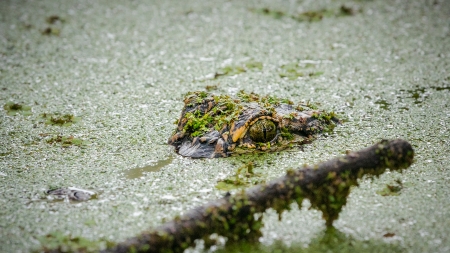A Swamp and 60 Feet
An unlikely community, in the most unlikely location, has become an even more unlikely force for public lands conservation.
All photos by Nathalie DuPré
The eyes would be easy to miss, rising an inch or two above the brackish water like burls on a half-sunken log. And we would have, if our Floridian companions hadn’t pointed them out, because we’d been focused on a pink flamingo lawn ornament tucked in the nearby foliage. Besides the two vertical pupils, the rest of the alligator’s scaled, 6-foot-long body is hidden under a mat of vibrant green algae. It blinks and disappears beneath the surface without a ripple.
A submerged dinosaur is strange enough. But this is Florida, where 12-foot alligators wander golf courses and 9-foot snakes and finger-chomping, 200-pound turtles hide among the swampy forests. Earlier, I came across an armadillo, the only animal (besides humans) known to carry leprosy. In such a menagerie of scaly horrors, one gator is hardly noteworthy.
The strip of dirt under our tires, however, very much is: a steep, purpose-built mountain bike trail in the center of the flattest and lowest state in the Union.
It’s 7 a.m. and temperatures are already edging toward 90 degrees at Balm Boyette Nature Preserve, a county park 30 miles to the southeast of Tampa. Moments before, I’d been chasing a crew of locals down a catwalk of a trail called North Abyss. Ferns and palmetto blanket the hillside to my left, their fronds brushing my knee like fingers. To my right is a near-vertical 15-foot plunge into alligator-infested waters. It’s like a pedal-powered rollercoaster through an Indiana Jones movie.
North Abyss is just one of Balm Boyette’s mountain bike-specific trails, a network stretching over 22 miles. Alafia River State Park, just a few minutes east, has 20 more, and Loyce E. Harpe Park, a half-hour drive to the northeast, has another 12. And they’re good. Like, really good. And really, really weird.
Fifty years ago, this was nothing but torn-up wasteland, the pockmarked remains of derelict phosphate mines. The pits and piles created by the mining process are now some of the most dramatic topographic relief in the state, with drops as much as 60 vertical feet. As Floridian mountain bikers have discovered, you can do a lot with 60 feet.
“There was nothing here before the mountain bike trails,” says Shane Richeson, president of Swamp Mountain Bike Club, the local advocacy group. “Now people coming from other states and other countries, here on vacation to go to the beach and Disney World, have something pop up on their phone that says you can mountain bike at Alafia River State Park. ‘Huh? You can do what?’”
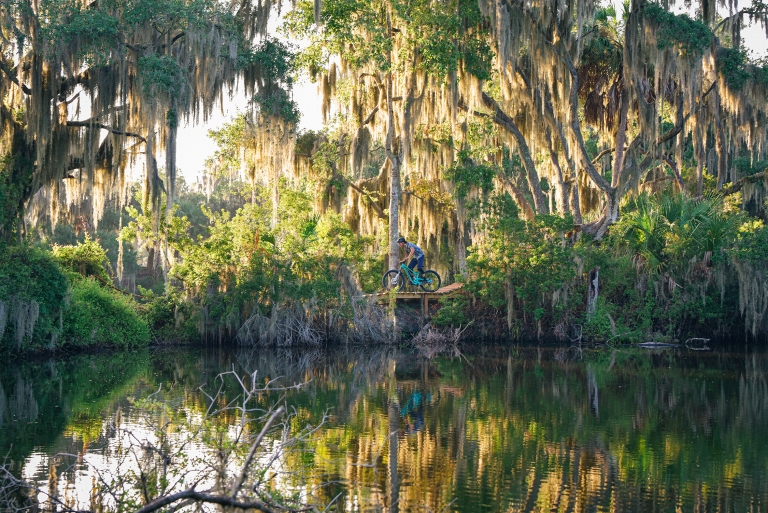
Writer Sakeus Bankson navigates the Ewok-style woodwork on Max Gs, a trail traversing one of the many knife-blade ridges jutting into the lakes at Loyce E. Harpe Park. The trails at the park are notoriously narrow, and riders fall into the water so often there’s a term for it: “joining the swim team.”
Central Florida’s Bone Valley is neither bony nor much of a valley. It stretches some 50 miles east of Tampa, past the retirement communities and golf cart traffic of the suburbs, and is eerily empty of towns, homes and even gas stations. There are no natural rock formations, just unrelenting green.
Dig 30 feet straight down, however, and you’ll find a museum’s worth of bones and teeth: ancient whales, giant sharks, 3-ton ground sloths, saber-toothed cats, border-collie-size horses and even mastodons. Over the past 25 million years, central Florida has vacillated from shallow ocean to grass-covered peninsula nearly twice its current width. (No dinosaurs, though; they were extinct 40 million years before the state rose above the waves.)
These fossil-packed sedimentary deposits also make up the country’s richest lode of phosphate rock, a mineral used in the production of agricultural fertilizers and feedstock. Extracting phosphate is an environmentally rapacious process, as evidenced by the Four Corners/Lonesome Mine, just a mile southeast of the Balm Boyette trailhead. The active mine spans over 50,000 acres, a raw, slightly radioactive wound of extraction pits and spoil piles.
Similar operations are scattered across central Florida, blips of elevation amid the flatness. Many more hide beneath the surface, smoothed over in accordance with state law that requires mining companies to reclaim, flatten and rehabilitate any surface mines developed after July 1, 1975. It does not, however, apply to those mined before 1975; those were largely abandoned, and the state and respective counties gathered the properties to protect them from development. The land was then usually left to its own devices, often for decades, during which nature did its inevitable thing.
“You had these large pieces of equipment come in, dig up the soil, put it in big piles, then leave,” says Danielle Ivey, environmental lands management coordinator for Hillsborough County, which encompasses Balm Boyette. “The amount of money it takes to then restore it is just astronomical. In the meantime, you’ve already got established vegetation. It might not be the exact vegetation or habitat you want, but it still benefits the wildlife. It’s still a functional system.”
Whatever wildlife remains, Balm Boyette is still as stunning as the trailhead is unassuming. The preserve is a half-mile pedal from the well-tended, highwayside parking lot, along a doubletrack between a sod farm and a solar panel array. Reach the forest, though, and it’s another world. Oak trees arc overhead with sheets of Spanish moss dripping from the branches to catch sunlight like pale green lace. Air plants nestle in the lofty rafters, linked by wrist-thick vines dangling from the canopy. The twittering orchestra of bird calls and insect sounds is overwhelming, an auditory wave of life so tangible it vibrates. It’s impossible to tell where the humidity ends and sweat begins, but the soggy air softens the sharp morning sun.
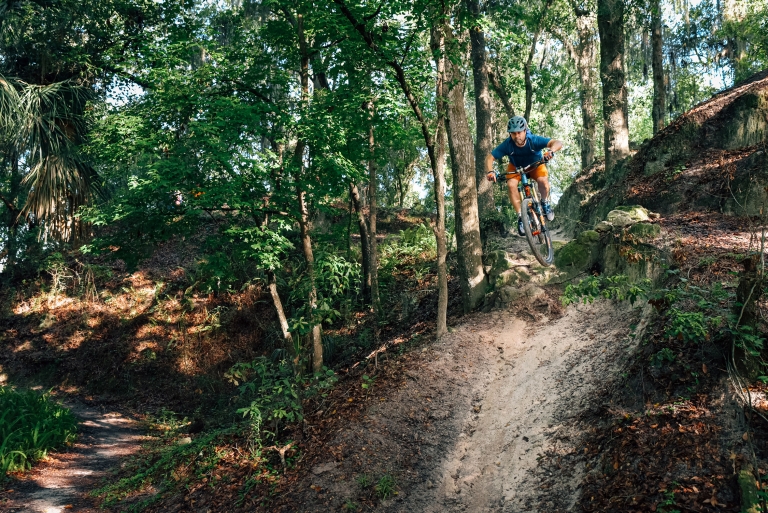
There’s no better testament to Florida’s trails than the skill of locals like Walter Mercier, a 53-year-old ultrasound technician who spends multiple days a week dropping, jumping and wheelieing along the trails at Alafia. You can get damn good on 60 vertical feet.
Curving through the green chaos, a ribbon of singletrack rises onto a rolling, unnaturally narrow ridge. The trail is named Ridgeline, and it’s the swooping gem of the Balm Boyette system. Buried under a carpet of ferns, the fin doesn’t look like a pile of industrial waste; it looks exotic and mysterious. Twenty-five years ago, that’s basically all this was: a few thousand acres of impenetrable, archetypal jungle surrounded by savannah, complete with feral (and invasive) pigs, scrub jays and herds of deer.
It was this rawness that brought Wes and Marty Eubank to Balm Boyette in August of 1995. The Eubanks founded Swamp (then the Southwest Association of Mountain Bike Pedalers) three years before in response to proposed trail closures in nearby Flatwoods/Wilderness Park, and Hillsborough County had invited them to the newly established 4,933-acre Balm Boyette Nature Preserve. Purchased through state and county conservation programs, the preserve included 800 acres of undisturbed scrub and scrubby flatwoods, rare ecosystems that support a variety of threatened and endangered species, alongside 1,200 acres of abandoned former phosphate mines.
“Nobody went there,” Wes says. “There was nothing. The land manager at the time had seen what the club had done in other locations and asked me to look at their property. I thought it was a joke. ‘You’re really asking me to come build trails?’”
Most of Florida’s trail systems are built on environmentally disturbed sites—quarries, landfills, sewage plants, even a failed cross-Florida canal. But pre-1975 phosphate mines are particularly conducive to mountain biking, and not just for their vertical relief. Spoil-pile dirt is far more compactible and erosion-resistant than the sandy surface soil, crucial for creating sustainable trails when you receive monsoon rains six months of the year. Even so, the unique topography requires a uniquely ridiculous amount of work. Swamp maintains some 120 miles of trail and has nearly 845 members, who put in over 9,000 volunteer hours each year. That’s over 75 hours per mile, every year.
“We started with 15 people, and I knew right off I had to build our numbers up,” Wes says. “We just brought people in, nurtured them and they stayed around. Now we’ve got people who have been in the club for 20 years.”
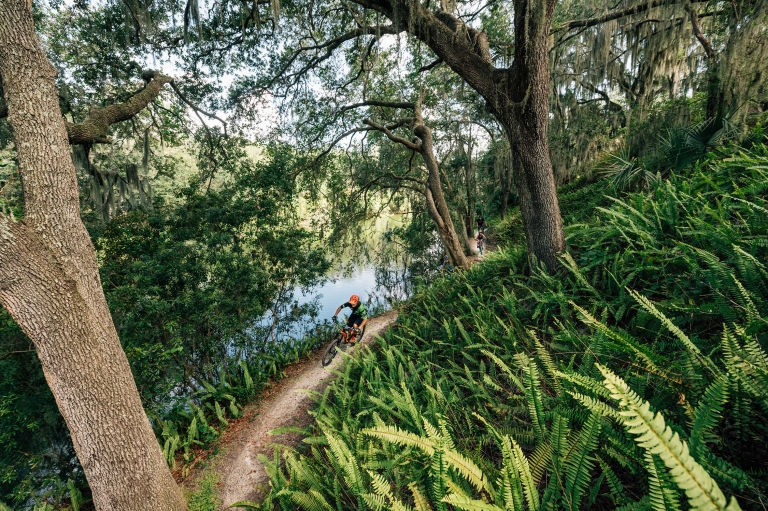
The Finger trails are some of Loyce E. Harpe Park’s most challenging; they’re also surrounded on three sides by gator-infested waters. Ridge Riders’ trail boss, Steve Spong, takes a lakeside cruise on one of the Finger return trails.
Chloe Leverington hasn’t been a member for two decades, but that’s only because she hasn’t been alive that long. Clad in a Wonder Woman cape and full-face helmet, the 11-year-old taps me on the shoulder and holds out a fist. “Want to see a shark tooth?” she asks. We’re paused along Rabbit Ears, a trail in Alafia River State Park, while our photographer, Nathalie DuPré, sets up around the bend.
Seeing my skepticism—we’re 40 miles from the nearest coast—Chloe opens her hand to reveal a serrated, 2-inch-long tooth. Cayden, her 9-year-old sister, offers up three smaller ones she just discovered in the cut bank along the trail. “We have a whole box at home,” Chloe tells me, holding her fingers a few inches apart. “We even have a megalodon—it’s like, this big!”
It’s a reasonable estimate: The 60-foot Carcharocles megalodon had teeth as long as 7 inches and swam the oceans that covered Florida 4 million years ago. When you spend as much time on Alafia’s trails as the Leverington sisters, you’re bound to find a few treasures and get absurdly good in the process.
Spread over another abandoned phosphate mine, the 6,312-acre Alafia River State Park is one of the most popular mountain biking destinations in the state, and the parking lot bustles with a wildly diverse spectrum of riders. Whereas Balm Boyette has minimal infrastructure, Alafia has all the trappings of a state park: an entrance sign and ranger-staffed guard station, a campground with showers, multiple pavilions, a restroom building, bike-washing and maintenance stations, and even an on-site bike shop.
But it’s the trails that earned Alafia its notoriety, 20 miles of mountain bike-only singletrack that wanders between, along and—in a few places—over the park’s numerous phosphate-pit lakes. The system is famous for its wooden features and bridges, which control erosion and serve as connectors through the park’s convoluted topography. Lacking a bedrock backbone, the landscape warps into goblet-shaped bowls, twisted ridges and triangular mounds that look like giant shark dorsal fins, some of which have singletrack along the top. Many are barely wider than the trail and tall enough that a fall could have serious consequences.
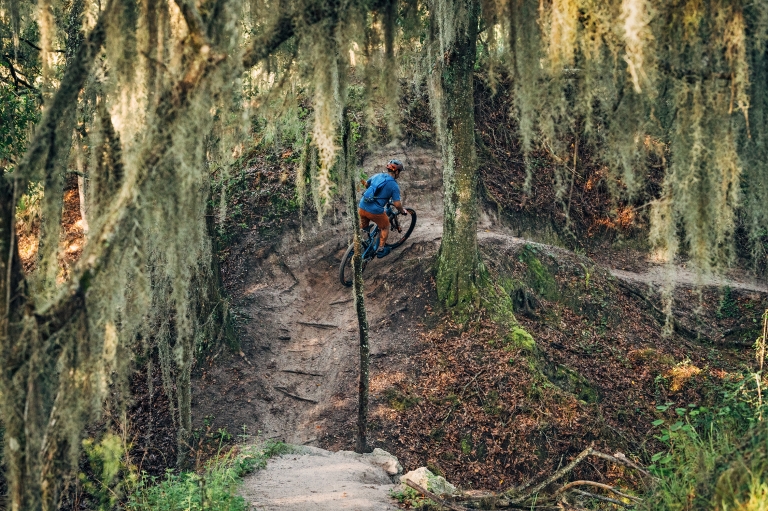
Walter surfs soil waves on Alafia’s Rabbit Ears, another bizarre trail carved from the area’s old mining spoil piles. Combined with the chaotic topography, this compactable, erosion-resistant dirt is what allows for the area’s surreal trail features.
Swamp started work at Alafia in 2000 and spent the next nine years expanding the trail system, eventually handing off maintenance responsibilities to the nonprofit Friends of Alafia in 2009. The club still holds group rides and events at the park, like the Alafia Fat Tire Festival, and Shane hopes to one day connect Alafia and Balm Boyette via singletrack. Shane stepped into the president role in 2018, after which he and Mike Lamarca, the club’s vice president, established the organization as a 501(c)(3) nonprofit. Since then, Shane has focused on advocacy efforts, like conservation, community education and collaboration between Florida’s scattered mountain bike groups.
One of those organizations is the Ridge Riders Mountain Bike Association, 30 miles away in Lakeland. Ridge Riders is nearly as old as Swamp and manages Carter Road trails, a 13-mile network comprising the south end of Loyce E. Harpe Park and bordering the wildlife-filled Se7en Wetlands. Home to otters, gopher tortoises, a variety of rare birds and massive gators, Carter Road is also home to the state’s most bizarre trails—the Fingers, a series of knife-blade ridges rising 60 feet above a lake and surrounded on three sides by water. Steve Spong, Ridge Riders’ trail boss, tells me people fall in so often they’ve dubbed it “joining the swim team.” It’s understandable; the ridges barely fit 2 widths of singletrack, and the out-and-back trails are stitched together with Ewok-style bridges and erosion-controlling features. Despite numerous close calls and a few wet tires, I’m able to avoid unintentional enrollment, but Steve still sets me up with a Carter Road Swim Team souvenir jersey.
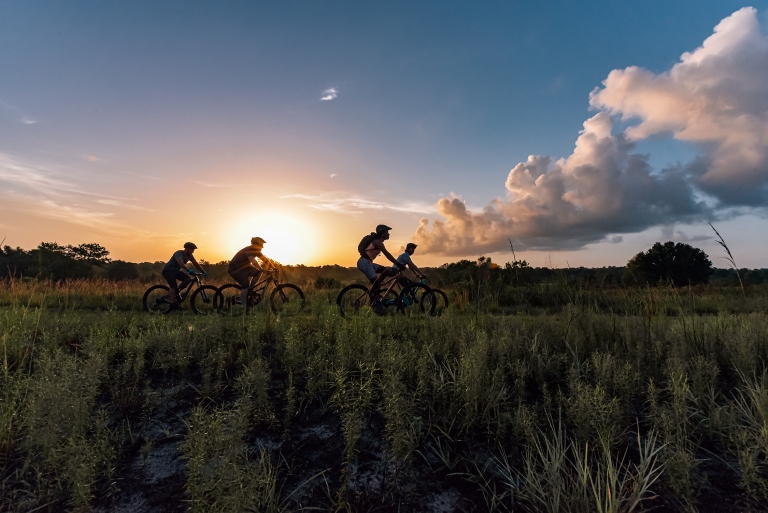
Tony Estevez, Spencer Marshall, Analise Cleopatra and Sakeus take a sunrise cruise through Balm Boyette’s savannah-esque grasslands. When the temperature and humidity percentage both top 90 by 7 a.m., you have to start early—really early.
It’s 6:30 p.m. when we pull into the Balm Boyette trailhead for our final ride, but it’s still a sweltering 90 degrees by the time we reach the trees. We’re here for Ridgeline, the G-force-inducing rollercoaster that is somehow both a freeride and cross-country trail and the best—and most exhausting—60 vertical feet I’ve ever ridden. Wes built it more than 15 years ago and still considers it his masterpiece. According to Mike and Spencer Marshall, senior trail crew member at Balm Boyette, it’s only gotten better. I believe them.
Exhausted, dehydrated and drenched, we spend the next hour drinking beer and exchanging stories in the parking lot. It’s a random mix, our ages as varied as our backgrounds, and the vehicles range from Toyota Priuses to lifted diesel trucks. We talk about far-flung destinations and dream trips, but the conversation always returns to the trails hidden in the trees on the horizon. As the sun dips below the preserve’s unkempt silhouette, I realize this is the wonder of Florida mountain biking: It’s united an unlikely community, in the most unlikely location, as an even more unlikely force for public lands conservation. And all it took was 60 feet.
This story was first published in the Patagonia Spring 2021 journal.
Analise charges one of the many precipitous steeps along Ridgeline, Balm Boyette’s signature trail. Built over 15 years ago by Swamp founder Wes Eubank, Ridgeline winds through 2 miles of raw, wild jungle—so wild, it’s easy to forget you’re only a few hundred yards from a sod farm.
The nine-banded armadillo is one of Balm Boyette’s cutest residents. It’s also the only animal (besides humans) known to carry leprosy.
Alafia’s bike-washing stations are crucial after muddy summer storms, and—as demonstrated by Swamp President Shane Richeson—even better for cooling off on 90-degree days.
Swamp’s original logo is as obvious as it is awesome, a heritage that longtime members like VP Mike Lamarca are proud to represent.
Artist, film director and Miami-based mountain biker Analise takes a few minutes of rest after her first day at Balm Boyette.
